Post # 186 -- COVID-19 Now a Pandemic
Dear Family and Friends
I bet you have all been either listening to or
watching the news to keep updated about the outbreak of this new virus which is
now a pandemic☹ I pray that you do not have family
members and friends who have been affected by this terrible virus that is
spreading so quickly throughout the world.
Please
remember that the Lord has his servants who hole His Priesthood here on the
earth today. These men have the authority to bless the sick in His name. These
men hold His power in their hands. If you can but desire to believe. What was
it that the man in the scriptures said to the Lord? Lord help thou mine
unbelief or something like that I think😊
Have
been concerned about this new virus that seems to be running rampant in our
world right now☹ I have three grandchildren who live in a
town a couple of hours from me and there are confirmed cases of this virus in
their little town. So, I wanted to find out more about this virus that we are dealing
with and I also teach preschool and I am in the higher risk of getting the
virus. You cannot fight something if your do not know what it is, or what it
looks like.
I felt
like maybe you too, might want to know this information as well so I am sharing
what I have learned in my search for answers. I hope that this is helpful to
you as well😊
How to Protect Yourself
alert icon
Older adults and people who have severe underlying chronic medical
conditions like heart or lung
disease or diabetes seem to be at higher risk for developing more serious
complications from COVID-19 illness. Please consult with your health care
provider about additional steps you may be able to take to protect yourself.
Know How it Spreads
·
There is currently no
vaccine to prevent coronavirus disease 2019 (COVID-19).
·
The
best way to prevent illness is to avoid being exposed to this virus.
·
The virus is thought to
spread mainly from person-to-person.
o Between people who are in close contact with one
another (within about 6 feet).
o Through respiratory droplets produced when an
infected person coughs or sneezes.
·
These droplets can land
in the mouths or noses of people who are nearby or possibly be inhaled into the
lungs.
Take steps to protect yourself
Clean your hands often
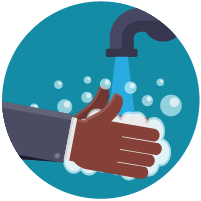 ·
Wash
your hands often with soap
and water for at least 20 seconds especially after you have been in a public
place, or after blowing your nose, coughing, or sneezing.
·
Wash
your hands often with soap
and water for at least 20 seconds especially after you have been in a public
place, or after blowing your nose, coughing, or sneezing.
·
If soap and water are
not readily available, use a hand sanitizer that contains at least 60%
alcohol. Cover all surfaces of your hands and rub them together until they
feel dry.
·
Avoid
touching your eyes,
nose, and mouth with unwashed hands.
Avoid close contact
·
Put distance
between yourself and other people if COVID-19 is spreading
in your community. This is especially important for people who are at higher risk of getting very sick.
Take steps to protect others
Stay home if you’re sick
Cover coughs and sneezes
·
Throw
used tissues in the trash.
·
Immediately wash
your hands with soap and water for at least 20 seconds. If soap and
water are not readily available, clean your hands with a hand sanitizer that
contains at least 60% alcohol.
Wear a facemask if you are sick
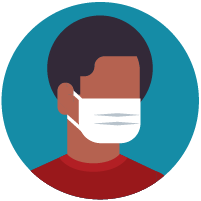 ·
If
you are sick: You should wear a
facemask when you are around other people (e.g., sharing a room or vehicle) and
before you enter a healthcare provider’s office. If you are not able to wear a
facemask (for example, because it causes trouble breathing), then you should do
your best to cover your coughs and sneezes, and people who are caring for you
should wear a facemask if they enter your room. Learn what to do if you are sick.
·
If
you are sick: You should wear a
facemask when you are around other people (e.g., sharing a room or vehicle) and
before you enter a healthcare provider’s office. If you are not able to wear a
facemask (for example, because it causes trouble breathing), then you should do
your best to cover your coughs and sneezes, and people who are caring for you
should wear a facemask if they enter your room. Learn what to do if you are sick.
·
If
you are NOT sick: You
do not need to wear a facemask unless you are caring for someone who is sick
(and they are not able to wear a facemask). Facemasks may be in short supply
and they should be saved for caregivers.
Clean and disinfect
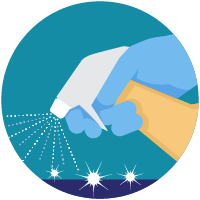 ·
Clean
AND disinfect frequently touched surfaces daily. This includes tables, doorknobs, light
switches, countertops, handles, desks, phones, keyboards, toilets, faucets, and
sinks.
·
Clean
AND disinfect frequently touched surfaces daily. This includes tables, doorknobs, light
switches, countertops, handles, desks, phones, keyboards, toilets, faucets, and
sinks.
·
If
surfaces are dirty, clean them: Use detergent or soap and water prior to disinfection.
To disinfect:
Most common EPA-registered household disinfectants will work. Use disinfectants appropriate for the surface.
Most common EPA-registered household disinfectants will work. Use disinfectants appropriate for the surface.
Options include:
·
Diluting
your household bleach.
To make a bleach solution, mix:
To make a bleach solution, mix:
o 5 tablespoons (1/3rd cup) bleach per gallon of
water
OR
OR
o 4 teaspoons bleach per quart of water
Follow
manufacturer’s instructions for application and proper ventilation. Check to
ensure the product is not past its expiration date. Never mix household bleach
with ammonia or any other cleanser. Unexpired household bleach will be
effective against coronaviruses when properly diluted.
·
Alcohol
solutions.
Ensure solution has at least 70% alcohol.
Ensure solution has at least 70% alcohol.
·
Other
common EPA-registered household disinfectants.
Products with EPA-approved emerging viral pathogens pdf icon[7 pages]external icon claims are expected to be effective against COVID-19 based on data for harder to kill viruses. Follow the manufacturer’s instructions for all cleaning and disinfection products (e.g., concentration, application method and contact time, etc.).
Products with EPA-approved emerging viral pathogens pdf icon[7 pages]external icon claims are expected to be effective against COVID-19 based on data for harder to kill viruses. Follow the manufacturer’s instructions for all cleaning and disinfection products (e.g., concentration, application method and contact time, etc.).
COVID-19
Now a Pandemic
A pandemic is a global outbreak
of disease. Pandemics happen when a new virus emerges to infect people and can
spread between people sustainably. Because there is little to no pre-existing
immunity against the new virus, it spreads worldwide.
The virus that causes COVID-19
is infecting people and spreading easily from person-to-person. Cases have been
detected in most countries worldwide and community spread is being detected in
a growing number of countries. On March 11, the COVID-19 outbreak was characterized
as a pandemic by the WHO.
This is the first pandemic known
to be caused by the emergence of a new coronavirus. In the past century, there
have been four pandemics caused by the emergence of novel influenza viruses. As
a result, most research and guidance around pandemics is specific to influenza,
but the same premises can be applied to the current COVID-19 pandemic.
Pandemics of respiratory disease follow a certain progression outlined in a “Pandemic Intervals
Framework.” Pandemics begin with an investigation phase, followed by
recognition, initiation, and acceleration phases. The peak of illnesses occurs
at the end of the acceleration phase, which is followed by a deceleration
phase, during which there is a decrease in illnesses. Different countries can
be in different phases of the pandemic at any point in time and different parts
of the same country can also be in different phases of a pandemic.
There are ongoing investigations
to learn more. This is a rapidly evolving situation and information will be
updated as it becomes available.
https://www.cdc.gov/coronavirus/2019-ncov/cases-updates/summary.html?CDC_AA_refVal=https%3A%2F%2Fwww.cdc.gov%2Fcoronavirus%2F2019-ncov%2Fsummary.html#source-spread
How It Spreads
COVID-19 is a new
disease and we are still learning how it spreads, the severity of
illness it causes, and to what extent it may spread in the United States.
How COVID-19 Spreads
Person-to-person spread
The virus is thought to
spread mainly from person-to-person.
·
Between people who are
in close contact with one another (within about 6 feet).
·
Through respiratory
droplets produced when an infected person coughs or sneezes.
These droplets can land
in the mouths or noses of people who are nearby or possibly be inhaled into the
lungs.
Can someone spread the virus without being sick?
·
People are thought to be
most contagious when they are most symptomatic (the sickest).
·
Some spread might be
possible before people show symptoms; there have been reports of this occurring
with this new coronavirus, but this is not thought to be the main way the virus
spreads.
Spread from contact with contaminated surfaces
or objects
It may be possible that
a person can get COVID-19 by touching a surface or object that has the virus on
it and then touching their own mouth, nose, or possibly their eyes, but this is
not thought to be the main way the virus spreads.
How easily the virus spreads
How easily a virus
spreads from person-to-person can vary. Some viruses are highly contagious
(spread easily), like measles, while other viruses do not spread as easily.
Another factor is whether the spread is sustained, spreading continually
without stopping.
The virus that causes
COVID-19 seems to be spreading easily and sustainably in the community
(“community spread”) in some affected geographic areas.
Community spread means people have been infected with the
virus in an area, including some who are not sure how or where they became
infected.
How to Clean and
Disinfect
Surfaces
- If surfaces are dirty, they
should be cleaned using a detergent or soap and water prior to
disinfection.
- For disinfection, diluted
household bleach solutions, alcohol solutions with at least 70% alcohol,
and most common EPA-registered household disinfectants should be
effective.
- Diluted household bleach
solutions can be used if appropriate for the surface. Follow
manufacturer’s instructions for application and proper ventilation. Check
to ensure the product is not past its expiration date. Never mix
household bleach with ammonia or any other cleanser. Unexpired household
bleach will be effective against coronaviruses when properly diluted.
- Prepare a bleach solution by
mixing:
- 5 tablespoons (1/3rd cup)
bleach per gallon of water or
- 4 teaspoons bleach per quart
of water
- Products with EPA-approved
emerging viral pathogens claimspdf iconexternal icon are
expected to be effective against COVID-19 based on data for harder to
kill viruses. Follow the manufacturer’s instructions for all cleaning and
disinfection products (e.g., concentration, application method and
contact time, etc.).
- For soft (porous) surfaces such
as carpeted floor, rugs, and drapes, remove visible contamination if
present and clean with appropriate cleaners indicated for use on these
surfaces. After cleaning:
- If the items can be laundered,
launder items in accordance with the manufacturer’s instructions using
the warmest appropriate water setting for the items and then dry items
completely.
- Otherwise, use products with
the EPA-approved emerging viral pathogens claims (examples at this linkpdf iconexternal icon)
that are suitable for porous surfaces
Linens, Clothing, and
Other Items That Go in the Laundry
- Do not shake dirty laundry;
this minimize the possibility of dispersing virus through the air.
- Wash items as appropriate in
accordance with the manufacturer’s instructions. If possible, launder
items using the warmest appropriate water setting for the items and dry
items completely. Dirty laundry that has been in contact with an ill
person can be washed with other people’s items.
- Clean and disinfect hampers or
other carts for transporting laundry according to guidance above for hard
or soft surfaces.
- Cleaning staff should wear
disposable gloves and gowns for all tasks in the cleaning process,
including handling trash.
- Gloves and gowns should be
compatible with the disinfectant products being used.
- Additional PPE might be
required based on the cleaning/disinfectant products being used and
whether there is a risk of splash.
- Gloves and gowns should be
removed carefully to avoid contamination of the wearer and the
surrounding area. Be sure to clean hands after
removing gloves.
- Gloves should be removed after
cleaning a room or area occupied by ill persons. Clean hands immediately after gloves
are removed.
- Cleaning staff should
immediately report breaches in PPE (e.g., tear in gloves) or any potential
exposures to their supervisor.
- Cleaning staff and others
should clean hands often,
including immediately after removing gloves and after contact with an ill
person, by washing hands with soap and water for 20 seconds. If soap and
water are not available and hands are not visibly dirty, an alcohol-based
hand sanitizer that contains 60%-95% alcohol may be used. However, if
hands are visibly dirty, always wash hands with soap and water.
- Follow normal preventive
actions while at work and home, including cleaning hands and avoiding
touching eyes, nose, or mouth with unwashed hands.
- Additional key times to clean
hands include:
- After blowing one’s nose,
coughing, or sneezing
- After using the restroom
- Before eating or preparing
food
- After contact with animals or
pets
- Before and after providing
routine care for another person who needs assistance (e.g., a child)
Preventing
the Spread of Coronavirus Disease 2019 in Homes and Residential Communities
OSHA has developed this interim guidance to help prevent worker
exposure to COVID-19.
U.S. Department of Defense
Regardless of specific exposure risks, following good hand
hygiene practices can help workers stay healthy year round.
General
guidance for all U.S. workers and employers
For all workers, regardless of specific exposure risks, it is
always a good practice to:
§ Frequently
wash your hands with soap and water for at least 20 seconds. When soap and
running water are unavailable, use an alcohol-based hand rub with at least 60%
alcohol. Always wash hands that are visibly soiled.
§ Avoid
touching your eyes, nose, or mouth with unwashed hands.
§ Avoid
close contact with people who are sick.
The U.S. Centers for Disease Control and Prevention has
developed interim
guidance for businesses and employers to plan for and respond
to COVID-19. The interim guidance is intended to help prevent workplace
exposures to acute respiratory illnesses, including COVID-19. The guidance also
addresses considerations that may help employers prepare for more widespread, community
outbreaks of COVID-19, in the event that this kind of transmission begins to
occur. The guidance is intended for non-healthcare settings; healthcare workers
and employers should consult guidance specific to them, below.
Interim
guidance for most U.S. workers and employers of workers unlikely to have
occupational exposures to COVID-19
Talking
with children about Coronavirus Disease 2019: Messages for parents, school
staff, and others working with children
How to Prepare
Here is what you can do
to prepare your family in case COVID-19 spreads in your community.
check circle solid icon
Find Local Information
Know where to find local
information on COVID-19 and local trends of COVID-19 cases.
check circle solid icon
Know the Signs &
Symptoms
Know the signs and symptoms of COVID-19 and what
to do if symptomatic:
·
Stay home when you are
sick
·
Call your health care
provider’s office in advance of a visit
·
Limit movement in the
community
·
Limit visitors
check circle solid icon
Take Steps for Those at
Higher Risk
Know what additional
measures those at higher risk and who are vulnerable should
take.
check circle solid icon
Protect Yourself &
Family
Implement steps to prevent illness (e.g., stay home
when sick, handwashing, respiratory etiquette, clean frequently touched
surfaces daily).
check circle solid icon
Create a Household Plan
Create a household plan of action in case of
illness in the household or disruption of daily activities due to COVID-19 in
the community.
·
Consider 2-week supply
of prescription and over the counter medications, food and other essentials.
Know how to get food delivered if possible.
·
Establish ways to
communicate with others (e.g., family, friends, co-workers).
·
Establish plans to
telework, what to do about childcare needs, how to adapt to cancellation of
events.
check circle solid icon
Stay Informed About
Emergency Plans
Know about emergency
operations plans for schools/workplaces of household members.
I hope what I
have shared with you today is helpful in protecting you and your family members
and friends from this new virus that is sweeping across the world. Just yesterday
my older grandson who I live with was throwing up and tonight his younger brother
and little sister were throwing up too. There is something going around our
household for sure. I do pray that yours is healthy and well on this day😊
Until my next post please stay healthy and make it a great week😊
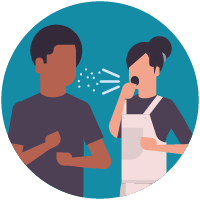
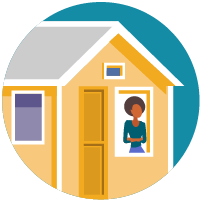
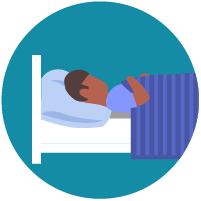
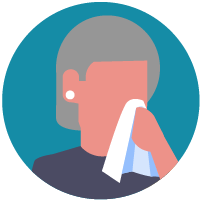
No comments:
Post a Comment